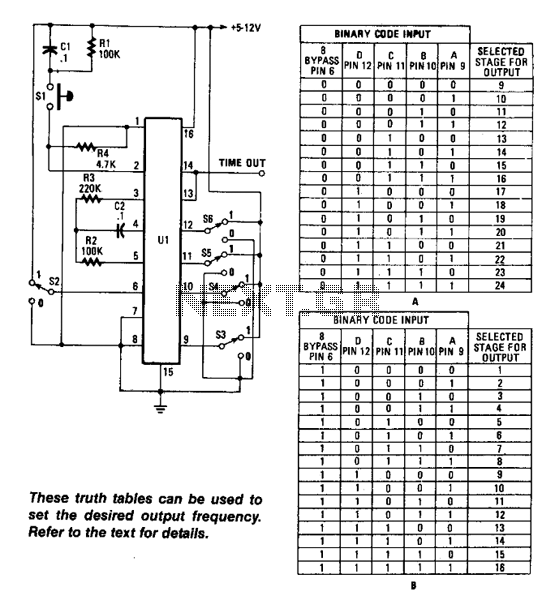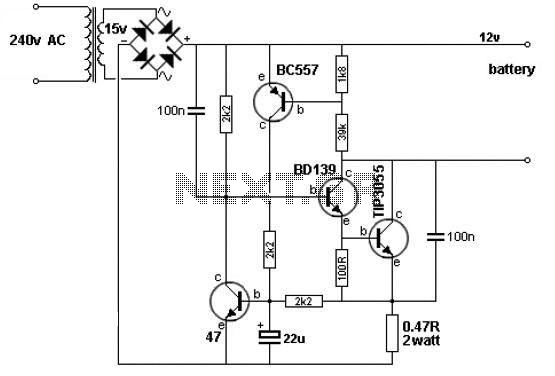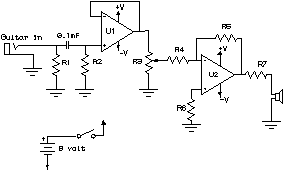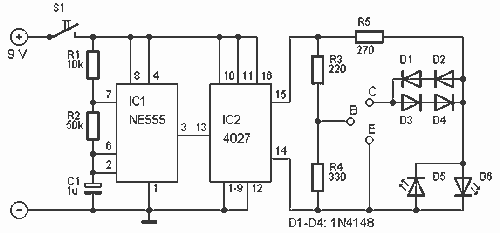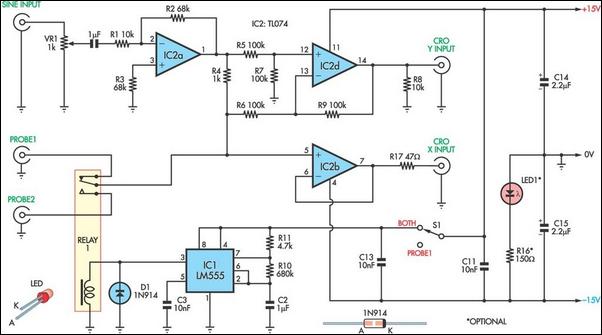
schematic long range fm
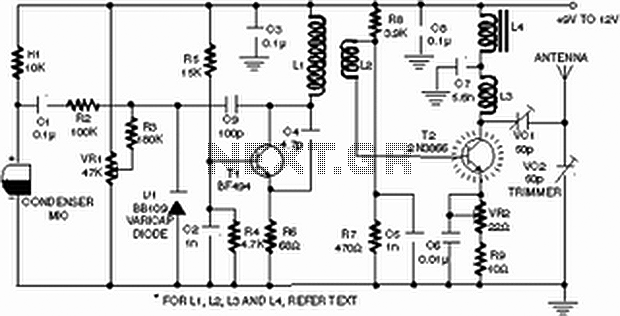
The power output of most of these circuits is very low because no power amplifier stages were incorporated. The transmitter circuit described here includes an additional RF power amplifier stage, following the oscillator stage, to increase the power output to 200-250 milliwatts. When paired with a well-matched 50-ohm ground plane antenna or a multi-element Yagi antenna, this transmitter can achieve reasonably good signal strength over a distance of approximately 2 kilometers. The circuit is built around transistor T1 (BF494), which functions as a basic low-power variable-frequency VHF oscillator. A varicap diode circuit is included to adjust the frequency of the transmitter and provide frequency modulation via audio signals. The output from the oscillator is approximately 50 milliwatts. Transistor T2 (2N3866) operates as a VHF-class A power amplifier, increasing the power of the oscillator signals by four to five times, thus generating 200-250 milliwatts of power at the collector of transistor T2. For optimal results, the circuit should be assembled on a high-quality glass epoxy board and housed within an aluminum enclosure. The oscillator stage should be shielded using an aluminum sheet. Coil winding specifications are as follows: L1 consists of 4 turns of 20 SWG wire closely wound over an 8mm diameter plastic former; L2 consists of 2 turns of 24 SWG wire near the top end of L1 (note that no core is used for these coils); L3 consists of 7 turns of 24 SWG wire closely wound with a 4mm diameter air core; L4 consists of 7 turns of 24 SWG wire wound on a ferrite bead to function as a choke. Potentiometer VR1 is utilized to vary the fundamental frequency, while potentiometer VR2 serves as a power control. For hum-free operation, the transmitter should be powered by a 12V rechargeable battery pack composed of 10 x 1.2-volt Ni-Cd cells. Transistor T2 must be mounted on a heat sink, and the transmitter should not be activated without a matching antenna. Both trimmers (VC1 and VC2) should be adjusted for maximum transmission power, and potentiometer VR1 should be set to establish the fundamental frequency near 100 MHz. This transmitter is intended solely for educational purposes.
The transmitter circuit features a well-defined architecture designed to enhance signal transmission capabilities in the VHF band. The initial stage, utilizing the BF494 transistor, serves as the oscillator, generating a variable frequency signal that can be modulated with audio input through the varicap diode. This modulation capability allows for effective transmission of audio signals alongside the carrier wave.
The subsequent amplification stage, employing the 2N3866 transistor, significantly boosts the output power. The design ensures that the final output, achieved at the collector of T2, reaches levels sufficient for effective communication over a distance of up to 2 kilometers. The careful selection of components, such as the specific wire gauges for coil winding, plays a critical role in achieving the desired resonant frequencies and impedance matching required for optimal performance.
The inclusion of a heat sink for transistor T2 is essential to prevent overheating during prolonged operation, which could otherwise lead to circuit failure. The use of a rechargeable battery pack ensures a stable power supply, which is crucial for maintaining consistent performance while minimizing hum and noise in the output signal.
The circuit's layout should prioritize compactness and shielding, particularly for the oscillator stage, to minimize interference and enhance overall signal integrity. The assembly on a glass epoxy board not only provides structural stability but also contributes to the reduction of parasitic capacitance, which can adversely affect the oscillator's performance.
In summary, this transmitter circuit is a well-engineered solution for educational applications, demonstrating the principles of RF amplification, frequency modulation, and circuit design. Its specifications and operational guidelines underscore the importance of careful assembly and component selection in achieving reliable and effective performance.The power output of most of these circuits are very low because no power amplifier stages were incorporated. The transmitter circuit described here has an extra RF power amplifier stage, after the oscillator stage, to raise the power output to 200-250 milliwatts.
With a good matching 50-ohm ground plane antenna or multi-element Yagi antenna, this t ransmitter can provide reasonably good signal strength up to a distance of about 2 kilometers. The circuit built around transistor T1 (BF494) is a basic low-power variable-frequency VHF oscillator. A varicap diode circuit is included to change the frequency of the transmitter and to provide frequency modulation by audio signals.
The output of the oscillator is about 50 milliwatts. Transistor T2 (2N3866) forms a VHF-class A power amplifier. It boosts the oscillator signals` power four to five times. Thus, 200-250 milliwatts of power is generated at the collector of transistor T2. For better results, assemble the circuit on a good-quality glass epoxy board and house the transmitter inside an aluminum case. Shield the oscillator stage using an aluminum sheet. Coil winding details are given below:L1 - 4 turns of 20 SWG wire close wound over 8mm diameter plastic former.
L2 - 2 turns of 24 SWG wire near top end of L1. (Note: No core (i. e. air core) is used for the above coils)L3 - 7 turns of 24 SWG wire close wound with 4mm diameter air core. L4 - 7 turns of 24 SWG wire-wound on a ferrite bead (as choke)Potentiometer VR1 is used to vary the fundamental frequency whereas potentiometer VR2 is used as power control.
For hum-free operation, operate the transmitter on a 12V rechargeable battery pack of 10 x 1. 2-volt Ni-Cd cells. Transistor T2 must be mounted on a heat sink. Do not switch on the transmitter without a matching antenna. Adjust both trimmers (VC1 and VC2) for maximum transmission power. Adjust potentiometer VR1 to set the fundamental frequency near 100 MHz. This transmitter should only be used for educational purposes. 🔗 External reference
The transmitter circuit features a well-defined architecture designed to enhance signal transmission capabilities in the VHF band. The initial stage, utilizing the BF494 transistor, serves as the oscillator, generating a variable frequency signal that can be modulated with audio input through the varicap diode. This modulation capability allows for effective transmission of audio signals alongside the carrier wave.
The subsequent amplification stage, employing the 2N3866 transistor, significantly boosts the output power. The design ensures that the final output, achieved at the collector of T2, reaches levels sufficient for effective communication over a distance of up to 2 kilometers. The careful selection of components, such as the specific wire gauges for coil winding, plays a critical role in achieving the desired resonant frequencies and impedance matching required for optimal performance.
The inclusion of a heat sink for transistor T2 is essential to prevent overheating during prolonged operation, which could otherwise lead to circuit failure. The use of a rechargeable battery pack ensures a stable power supply, which is crucial for maintaining consistent performance while minimizing hum and noise in the output signal.
The circuit's layout should prioritize compactness and shielding, particularly for the oscillator stage, to minimize interference and enhance overall signal integrity. The assembly on a glass epoxy board not only provides structural stability but also contributes to the reduction of parasitic capacitance, which can adversely affect the oscillator's performance.
In summary, this transmitter circuit is a well-engineered solution for educational applications, demonstrating the principles of RF amplification, frequency modulation, and circuit design. Its specifications and operational guidelines underscore the importance of careful assembly and component selection in achieving reliable and effective performance.The power output of most of these circuits are very low because no power amplifier stages were incorporated. The transmitter circuit described here has an extra RF power amplifier stage, after the oscillator stage, to raise the power output to 200-250 milliwatts.
With a good matching 50-ohm ground plane antenna or multi-element Yagi antenna, this t ransmitter can provide reasonably good signal strength up to a distance of about 2 kilometers. The circuit built around transistor T1 (BF494) is a basic low-power variable-frequency VHF oscillator. A varicap diode circuit is included to change the frequency of the transmitter and to provide frequency modulation by audio signals.
The output of the oscillator is about 50 milliwatts. Transistor T2 (2N3866) forms a VHF-class A power amplifier. It boosts the oscillator signals` power four to five times. Thus, 200-250 milliwatts of power is generated at the collector of transistor T2. For better results, assemble the circuit on a good-quality glass epoxy board and house the transmitter inside an aluminum case. Shield the oscillator stage using an aluminum sheet. Coil winding details are given below:L1 - 4 turns of 20 SWG wire close wound over 8mm diameter plastic former.
L2 - 2 turns of 24 SWG wire near top end of L1. (Note: No core (i. e. air core) is used for the above coils)L3 - 7 turns of 24 SWG wire close wound with 4mm diameter air core. L4 - 7 turns of 24 SWG wire-wound on a ferrite bead (as choke)Potentiometer VR1 is used to vary the fundamental frequency whereas potentiometer VR2 is used as power control.
For hum-free operation, operate the transmitter on a 12V rechargeable battery pack of 10 x 1. 2-volt Ni-Cd cells. Transistor T2 must be mounted on a heat sink. Do not switch on the transmitter without a matching antenna. Adjust both trimmers (VC1 and VC2) for maximum transmission power. Adjust potentiometer VR1 to set the fundamental frequency near 100 MHz. This transmitter should only be used for educational purposes. 🔗 External reference
